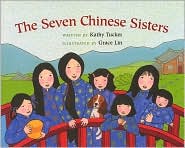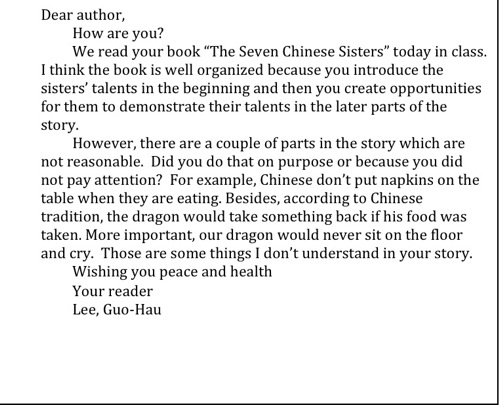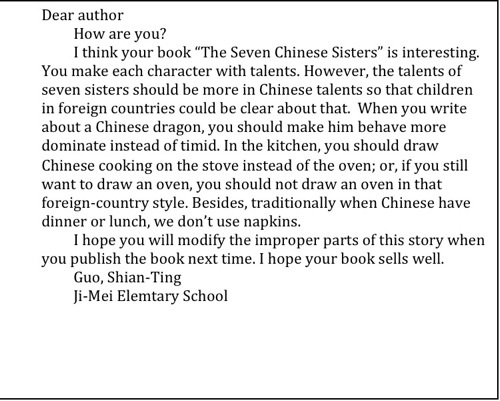The Responses of Third Graders in Taiwan to The Seven Chinese Sisters
The clothing of the girls is not like Chinese.
That dog is cute; it looks like Beagle.
No, it does not look like a Chinese dog!
These responses were students’ immediate comments when Yi-Jun showed them the cover illustration and title for The Seven Chinese Sisters. Yi-Jun then said, “This is a story about Chinese people which was written and illustrated by foreign authors. Maybe you could think about whether there is anything about how Chinese people are portrayed in this book that is different from what you know.”
The Seven Chinese Sisters is a retelling of an ancient Chinese folktale of seven sisters, each of whom has a unique skill. Written by Kathy Tucker and illustrated by Grace Lin, a Chinese American, the book is only available in English. Teacher educator, Wenyun, and classroom teacher, Yi-Jun, were curious about how Taiwanese children would respond to a book about Chinese culture that is not culturally authentic. We knew that there were a range of problems in the book, such as the image of the dragon, the clothing worn by the sisters, the windows in the house, and the furnishings of the kitchen (see http://wowlit.org/on-line-publications/review/reviewi3/7 for a review of the cultural authenticity of the book).
We engaged third graders in talking about this book. In class, Yi-Jun read aloud the book aloud in Chinese, translating each page from English to Chinese. After each page, she stopped to invite students to respond. The discussion began with the following comments:
- Yi-Jun (showing the cover page) :
The title of story is The Seven Chinese Sisters
- Chion-Yi:
Is it Chinese or Vietnamese.
- Yi-Jun:
What do you mean by this?
- Chion-Yi:
The way they are dressed is not like Chinese clothing; instead, it is more like Vietnamese.
- Chen-Yi:
That dog is cute but it looks like Beagle.
- Yi-An:
No, Beagle is not Chinese.
“You all sound reasonable.”
- Yi-June responded and read aloud the next page.
Wenyun and Yi-Jun were amazed by this discussion. It showed that students were applying what they had learned about Vietnam from a study that occurred weeks before reading this story. Although we did not share our opinion of the book during the discussion, we agreed with students that the clothing in the book looks more like Vietnamese clothing instead of Chinese. The clothing of the girls in the story is called cheongsam, a close-fitting Chinese dress with side vents. Students pointed out that it was not Chinese because Chinese ladies don’t wear long pants under the cheongsam as shown in the illustrations. Also, cheongsam is fitted instead of loose.
Yi-June kept reading aloud page by page and inviting students to respond. Some of the other comments by students included:
- Ming-Yin:
There was no scooter in ancient China.
- Yi-Shen:
Chinese dragons don’t live in a cave; instead, they live in the cloud or in the water.
- Mon-Shuan:
Why is there English on the rice bag?
- Zi-Yi:
Why is there a gas burner in the kitchen?
- Yu-Mai: T
he chopping board in ancient China was round and made by wood. My grandma has one.
These students pointed out details that are not culturally authentic in the illustrations. Their comments demonstrate their knowledge about Chinese culture, such as the image of dragon and the chopping board. Throughout the discussion, students focused on the mismatch of ancient and modern life, especially in the household objects and furnishings displayed in the story.
Other students paid more attention to the rationality of the story and whether the plot made sense to them:
- Bi-Hen:
How come the human being can speak to the dog?
- Shang-Jia:
Why can the youngest sister speak all of a sudden? How could the sisters know that it was their youngest sister who called for help since they had never heard how their youngest sister spoke?
- Yun-Jin:
Anyone who can speak to a dog cannot necessarily speak to the dragon.
- Yin-Zi:
If I were a dragon, I would eat the sister right away with salt.
- Chion-Yi:
Why did the sisters count the tree? Who would do that for nothing?
- Shang-Jia:
They would not find their way home even if they counted five hundred trees because they went to the wrong direction.
As the discussion kept going, the students seemed to pay more attention to whether the context made sense and was rational instead of to the cultural authenticity of the story and illustrations. We were curious about how students would respond to the book if they thought through the book by themselves, without our suppport. Therefore, Yi-Jun did a picture walk of the book after the discussion, and asked students to write a journal entry responding to the book. However, most of the journals still showed that they focused on the rationality of the story instead of the cultural authenticity. Here are some of their responses:
- •There should be no modern stuff in ancient China. (4 entries)
- •There was no scooter in ancient China. (8 entries)
- •The big sister should ride a bicycle or three-wheel bicycle instead of a scooter. (2 entries)
- •The way the sisters dressed does not fit the modern society if it is a story for the modern world. (1 entry)
From the journals, we found that most students responded positively when Yi-Jun asked if they liked the story. Wei-Ling, Pei-Shien and Yi-Je said, “It is a good book since every one in the story uses their full talents.” Ting-Gan said, “I like that they worked together to rescue their youngest sister, and they help each other and work together. “ Chien-Yi said, “I like this story although somethings are nonsense in the story to Chinese. However, as a story, it is reasonable. Basically, it is a good story.”
At first, Wenyun wondered why students seemed to focus on the rationality of the story instead of cultural authenticity, which is what she expected them to explore. After reflection on the content of the curriculum, she realized that their responses probably reflected the national curriculum, which does not support third graders with knowledge about Chinese culture. No wonder students focused their responses on what made sense within the story. Still, there were two students who chose to write to the author as their reflection. Their letters demonstrate that they were aware that some parts of the story are not culturally authentic.
Teachers are often impressed by the creative ways in which students think, but they may not realize the potential for students to also think critically about issues in books, primarily because students are seldom given the chance to share their critical perspectives. Actually, many teachers themselves are not critical thinkers. Growing up in the Chinese culture where books and written texts are highly respected and considered a final authority, teachers as well as students are not encouraged to challenge the books, especially learning materials such as textbooks and children’s books. This classroom story demonstrates that children can challenge the text if given the opportunity. Through responding to books about their culture, children can explore their cultural knowledge and also have a sense of how people of other cultures perceive their culture. Talking about global literature provides a way to explore one’s own and other’s cultures.
Tucker, K. (2003). The seven Chinese sisters. Ill. G. Lin. Albert Whitman.
Wenyun Lin is an assistant professor of the Department of Language and Creative Writing in National Taipei University of Education in Taiwan. She teaches children’s literature, reading and language curriculum development.




One thought on “WOW Stories: Connections from the Classroom”
Comments are closed.